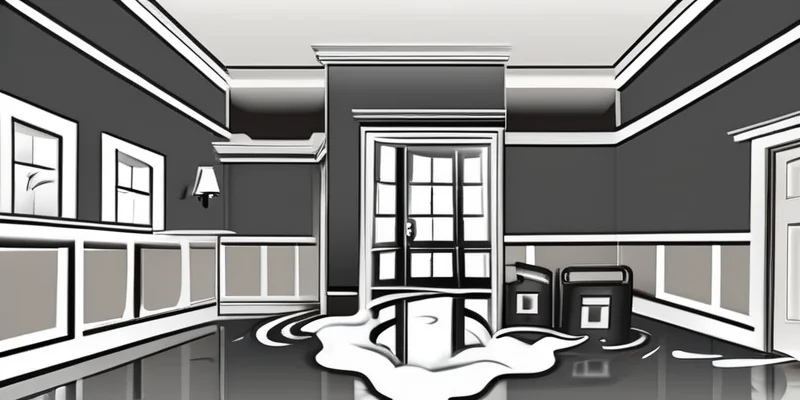What to Do After a Flood: Immediate Actions for Water Damage Restoration

Floods are a common and devastating natural disaster that can cause significant water damage to homes and businesses. Floodwater often contains contaminants that pose health risks, and prolonged exposure to water can lead to mold growth, structural damage, and other issues. It's crucial to take immediate action to minimize damage, protect your property, and ensure a successful restoration.
This guide provides a step-by-step approach to addressing water damage after a flood, including safety considerations, emergency response actions, and long-term restoration strategies. By following these guidelines, you can mitigate risks, protect your property, and ensure a swift return to normalcy.
Jump to:
- TLDR: Quick Guide to Flood Water Damage Restoration
- Safety Considerations for Flood-Affected Areas
- Emergency Response Actions for Flood Water Damage
- Long-Term Restoration Strategies for Flood-Damaged Properties
- Key Takeaways
- FAQs
TLDR: Quick Guide to Flood Water Damage Restoration
- Floodwater often contains contaminants that pose health risks
- Prolonged exposure to water can lead to mold growth and structural damage
- Take immediate action to minimize damage and protect your property
- Follow safety guidelines, document damage, and contact professionals
- Implement long-term restoration strategies to ensure a successful outcome
Safety Considerations for Flood-Affected Areas
Before entering flood-affected areas, it's essential to ensure safety:
Electrical Safety:
- Avoid contact with water and electrical equipment
- Turn off the main power if safe to do so
- Stay away from downed power lines
- Use flashlights instead of candles
Structural Safety:
- Inspect for structural damage before entering
- Avoid walking on weakened or unstable floors
- Be aware of potential hazards like fallen objects
- Evacuate if necessary due to immediate danger
Health and Safety:
- Wear protective clothing (gloves, boots, etc.)
- Avoid contact with contaminated water or materials
- Use respiratory protection if necessary
- Follow proper handling and disposal procedures for contaminated materials
Emergency Response Actions for Flood Water Damage
Immediate action is crucial to minimize damage and protect your property:
Document Damage:
- Take photos and videos of the damage
- Document any visible mold growth
- Record the date, time, and location of the flood
Contact Professionals:
- Call your insurance provider to file a claim
- Contact a professional water damage restoration company
- Consider hiring a licensed contractor for repairs
Emergency Water Extraction:
- Use a wet/dry vacuum or submersible pump to remove water
- Extract water from carpets and upholstery if safe to do so
- Remove standing water from floors and basements
Temporary Protection:
- Place buckets under active leaks
- Use sandbags to prevent water entry
- Tarp outdoor areas to protect from further damage
Mold Prevention:
- Dry wet areas within 24-48 hours
- Use dehumidifiers to control moisture levels
- Address any water sources or leaks promptly
Long-Term Restoration Strategies for Flood-Damaged Properties
Long-term restoration strategies ensure a successful outcome:
Structural Repairs:
- Address any structural damage caused by the flood
- Consult with a structural engineer if necessary
- Repair or replace damaged building materials
Content Restoration:
- Salvage and restore damaged personal belongings
- Professional cleaning and deodorization services may be needed
- Dispose of contaminated items appropriately
Mold Remediation:
- Address mold growth promptly to prevent health risks
- Consult with a professional mold remediation company
- Implement a mold remediation plan to ensure long-term success
Reconstruction:
- Reconstruct affected areas to pre-flood condition
- Consider upgrades or improvements during reconstruction
- Ensure proper ventilation and moisture control
Key Takeaways
- Floodwater often contains contaminants that pose health risks
- Prolonged exposure to water can lead to mold growth and structural damage
- Take immediate action to minimize damage and protect your property
- Follow safety guidelines, document damage, and contact professionals
- Implement long-term restoration strategies to ensure a successful outcome
FAQs
How long should I wait before entering a flood-affected area?
It's generally safe to enter a flood-affected area once the water has receded and electricity has been turned off. However, it's essential to assess structural integrity and potential hazards before entering.
Can I use household cleaning products to clean up after a flood?
It's not recommended to use household cleaning products for flood cleanup. These products may not be effective in removing contaminants and may pose health risks. Professional cleaning services are recommended.
How can I prevent mold growth after a flood?
To prevent mold growth, dry wet areas within 24-48 hours, use dehumidifiers, and address any water sources or leaks promptly. Regular inspections and maintenance can also help prevent future mold issues.
What should I do if I find mold after a flood?
If you find mold after a flood, it's crucial to address it promptly. Consult with a professional mold remediation company and implement a mold remediation plan to ensure long-term success and prevent health risks.
How long does it take to restore a flood-damaged property?
The time it takes to restore a flood-damaged property varies depending on the extent of damage, the scope of restoration work, and the availability of resources. Professional restoration companies can provide a more accurate timeline based on the specific circumstances.
